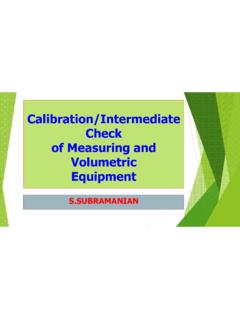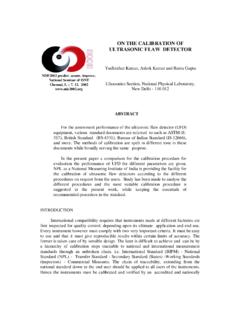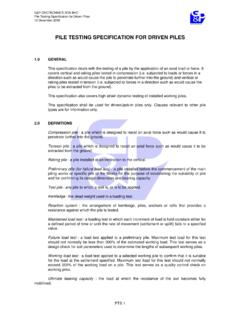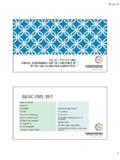Transcription of Selecting Appropriate Calibration Intervals - …
1 Selecting Appropriate Calibration IntervalsSources ILAC-G24, Guidelines for the determination of Calibration Intervals of measuring instruments ( ) NCSL International RP-1, Establishment and Adjustment of Calibration Intervals ( ) ExperiencesWhy do we calibrate? To check the accuracy of a measuring instrument. To improve the accuracy of a measuring instrument. To have confidence in a measuring instrument s results. To test a new instrument. To test an instrument after it has been repaired or modified. To check the operation of an instrument which has had a shock, vibration, or exposure to adverse conditions. Because many instruments results tend to drift over time. To ensure the best result prior to and after a critical measurement. Because measurements are important! Measurement and measurement-related operations have been estimated to account for between 3% and 6% of the GDP of industrial World, February 2009 Risks of Not Calibrating Equipment downtime Production downtime Inaccurate results Need for rework Loss of money Safety concernsSo how often should/must we recalibrate?
2 Calibration Intervals What do the standards require? Calibration programmesshall be established for key quantities or values of the instruments where these properties have a significant effect on the results. (ISO/IEC 17025, Section ) Before being placed into service, be calibrated or checked to establish that it meets the laboratory s specification requirements and complies with the relevant standard specifications. (ISO/IEC 17025, Section ) .. Calibration shall be labeled, coded, or otherwise identified to indicate or expiration criteria when recalibration is due. (ISO/IEC 17025, Section ) When, for whatever reason, equipment goes outside the direct control of the laboratory, the laboratory shall ensure that the function and Calibration status of the equipment are checked and shown to be satisfactory before the equipment is returned to service.
3 (ISO/IEC 17025, Section ) The laboratory shall have a programmeand procedure for the Calibration of its reference standards. (ISO/IEC 17025, Section )CAVEATS Your accreditation body may have specific requirements. Your industry may have specific requirements. Testing standards may have specific any of these apply to you?How often do you change your oil?Should everybody follow the same interval ? Every 3,000 miles? Every 5,000 miles? Every 7,500 miles? Every 3 months? When the oil looks dirty? When the viscosity of the oil changes? When you remember? When you have time?Factors to What type of instrument is it? What interval does the manufacturer recommend? What is the extent and severity of use and what are the environmental conditions? Does it have a tendency to wear of drift? What is the measurement uncertainty required? What is the risk of an instrument exceeding the maximum permissible error?
4 What is the cost of correction and recall measures when the instrument is found to be out of Calibration ? What does previous Calibration data tell you? Are intermediate checks performed? Have the personnel been trained appropriately?From ILAC-G24 For how long is a measurement uncertainty estimate valid? A Calibration , and the corresponding measurement uncertainty, are just a snapshot in time. Our knowledge of the values of the measurable attributes of a calibrated item begins to diminish from the time the item is calibrated. This loss of knowledge of the values of attributes over time is called uncertainty growth. (NCSL International RP-1) Whendoes it exceed your out-of-tolerance condition?Reliability vs. TimeInterval Selection MethodsEstablishing a Calibration IntervalToo ShortToo LongSetting the Initial interval Be conservative. Because you don t know what to expect.
5 So you can collect more data Periodic Calibration Required No periodic Calibration required or NPCR status may be assigned to some the instrument does not make the instrument does not make critical the instrument makes measurements which only provide an indication of operational status but does not provide a numerical the operation of the instrument is unlikely to )Ductility rulerCalibration interval OptionsFixed Intervals (every 6, 12 )Pros Easy to implement Easy to remember Easy to schedule Easy record-keeping Requires little expertise for staffCons Out-of- Calibration equipment may be in use Test reports/products may need to be recalled Equipment may be calibrated too often = extra costHow often?General interval (single interval for everything)Pros Easy to implement Easy to remember Easy to schedule Easy record-keeping Requires little expertise for staffCons Out-of- Calibration equipment may be in use Test reports/products may need to be recalled Equipment may be calibrated too often = extra costAutomatic Adjustment(aka Staircase)Pros Intervals based on data Easy to implement Requires little expertise for staffCons interval adjustments are responses to single Calibration events.
6 Unbalanced workload difficult to track deadlines Out-of- Calibration equipment may be in use Test reports/products may need to be recalled Equipment may be calibrated too often = extra costILAC-G24: Each time an instrument is calibrated, the subsequent interval is extended if it is found to be within the maximum permissible error required for measurement, or reduced if found to be outside this maximum permissible error. (Called Simple Response Method in NCSL International RP-1.)In-Use TimePros Requires little expertise for staff Tracks equipment in-use time Number of calibrations varies directly with length of time in use. Some instruments drift over Cannot be used with all instruments Cost of timers can be high Unbalanced workload difficult to track deadlines Out-of- Calibration equipment may be in use Test reports/products may need to be recalled Equipment may be calibrated too often = extra costILAC-G24: Calibration Intervals are expressed in hours of use instead of calendar IntervalsPros Easy to implement Hard work is already done Possibly requires little expertise for staffCons Depends on which method you borrow How do you know when Intervals change?
7 Must have similar risk toleranceOrganizations mustbe similar with respect to Calibration procedures, usage and handling of equipment, and ChartsPros Calibration Intervals are flexible Can help to predict out of control situations = time to recalibrateCons More work Unbalanced work loadControl Chart Example Data A laboratory places a nominal 2000-g mass on a balance each morning and takes five readings. The measurements are recorded and then collected in a spreadsheet. Each set of five readings is considered a subgroup. Subgroup averages and ranges are calculated. The average of the subgroup averages and the average of the subgroup ranges are calculated after approximately twenty subgroups. Control Chart DataGraph the Data (Average (X-bar) Chart)An out-of-control condition in the average ( X ) chart indicates a shift in the population average and could be due to the measuring equipment going out of Calibration or some problem with the check standard itself.
8 Range (R) ChartAn out-of-control condition in the range (R) chart indicates an increase in the dispersion of the repeat observations, which could be attributed to inadequate control of the environment or incompetence of the operator involved in the Rules In Statistical Process Control, the Western Electric Rules are decision rules for detecting "out-of-control" or non-random conditions on control charts. Locations of the observations relative to the control chart control limits (typically at 3 standard deviations) and centerline indicate whether the process in question should be investigated for assignable causes. The Western Electric Rules were codified by a specially-appointed committee of the manufacturing division of the Western Electric Company and appeared in the first edition of its Statistical Quality Control Handbook in 1956. Their purpose was to ensure that line workers and engineers interpret control charts in a uniform RulesAny Point Above +3 Sigma----------------------------------- ----------+3 LIMIT2 Out of the Last 3 Points Above +2 Sigma----------------------------------- ----------+2 LIMIT4 Out of the Last 5 Points Above +1 Sigma----------------------------------- ----------+1 LIMIT8 Consecutive Points on This Side of Control Line==================================== === CENTERLINE8 Consecutive Points on This Side of Control Line------------------------------------ --------- 1 LIMIT4 Out of the Last 5 Points Below 1 Sigma----------------------------------- ----------- 2 LIMIT2 Out of the Last 3 Points Below 2 Sigma----------------------------------- ---------- 3 LIMITAny Point Below 3 Sigma Trend Rules.
9 6 in a row trending up or down, 14 in a row alternating up and RulesWECO RulesWECO RulesWECO RulesCalibration SoftwarePros ?Cons Cost Requires some expertise Removes thought process interval Methods Fixed Intervals General interval Automatic adjustment (staircase) In-use time Similar items Borrowed Control charts Calibration softwar







